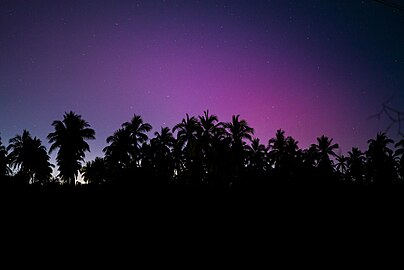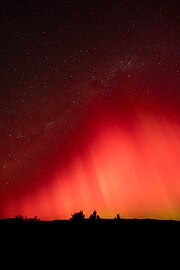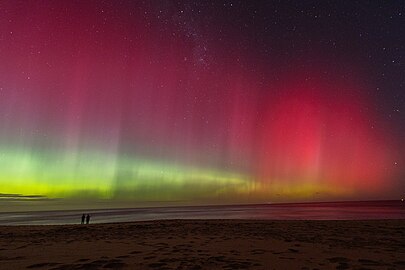May 2024 solar storms
This article is about a current solar storm where information can change quickly or be unreliable. The latest page updates may not reflect the most up-to-date information. Please refer to your local weather service or media outlets for the latest weather information pertaining to a specific location. |
 Aurora borealis as photographed from Viola, Arkansas (36°N, 46°N)[a] | |
| Type | Geomagnetic storm |
|---|---|
| Formed | 10 May 2024 |
| Dissipated | 13 May 2024 |
| Areas affected | Worldwide |
Part of Solar cycle 25 | |
The solar storms of May 2024 were a series of powerful solar storms with extreme solar flares and geomagnetic storm components that occurred from 10–13 May 2024 during solar cycle 25. The geomagnetic storm was the most powerful to affect Earth since October 2003, and produced aurorae at far lower latitudes than usual in both the northern and southern hemispheres.[1][2]
Solar flares and coronal mass ejections[edit]
On 8 May 2024, a solar active region which had been assigned the NOAA region number 13664 (AR3664) produced an X1.0-class and multiple M-class solar flares and launched several coronal mass ejections (CMEs) toward Earth.[3] On 9 May, the active region produced an X2.25- and X1.12-class flare each associated with a full-halo CME. On 10 May, the region produced an X3.98-class flare, and on 11 May at 01:23 UTC it produced another X-class flare of magnitude 5.4–5.7 with another asymmetrical full-halo CME.[4][5][6] The region also caused an S1 solar radiation storm with spikes reaching S2.[7] On 14 May, as the most active region 3664 rotated beyond the sun's western limb, the strongest flare occurred, an X8.7, causing level R3 (strong) radio blackouts.[8]
Geomagnetic storm[edit]

Because the interplanetary magnetic field reached a magnitude of 73 nT (nanotesla) with the component along Earth's magnetic axis oriented strongly south, reaching as much as −50 nT, as well as because of moderately high solar wind density, and solar wind speed reaching 750–800 km/s (470–500 mi/s) between 11–12 May (UTC time), the event was classified as a G5-class geomagnetic storm (Kp=9), making it the most intense storm since the 2003 Halloween solar storms.[9][10] Several other CMEs were expected to reach Earth on 11 and 12 May.[11]
Comparison to other geomagnetic storms[edit]
The disturbance storm time index (Dst index) is a measure in the context of space weather. A negative Dst index means that Earth's magnetic field is weakened.[12] This is particularly the case during solar storms, with a higher negative Dst index indicating a stronger solar storm.
The 2003 Halloween solar storms had a peak Dst index of −422 nT,[13] while the March 1989 geomagnetic storm had a peak Dst index of −589 nT.[14] The May 1921 geomagnetic storm has been estimated to have had a Dst index of −907±132 nT. Estimates for the Dst index of the Carrington Event superstorm of 1859 are between −800 nT and −1750 nT.[15]
The May 2024 solar storms reached a maximum Dst index of −412 nT on 11 May.[16]
Aurora sightings[edit]
Three CMEs from 8 May reached Earth on 10 May 2024, causing severe to extreme geomagnetic storms with bright and very long-lasting aurorae.
In Asia, aurorae could be seen from Japan,[18] the remote village of Hanle in northern India,[19] and near the cities of Urumqi and Beijing in China.[20][21]
In Europe, aurorae were seen from as far south as Cyprus,[22] Portugal,[23] and Spain.[24] Aurorae were also visible in Algeria and the Canary Islands in Africa.[25][26]
In North America, aurorae were seen as far south as the Florida Keys,[27][28][29] the Yucatán Peninsula in Mexico,[30] The Bahamas,[31] and Puerto Rico.[32] The aurora was also seen in Hawaii.[33]
In the Southern Hemisphere, the aurora was seen in New Zealand,[34] Chile, Argentina,[35] South Africa,[36] and as far north as Uruguay,[37] Namibia,[36] and Mackay in Queensland, Australia.[38][39]
Impact[edit]
The storm negatively affected ground-based broadcasting and two-way radio communications, especially on the HF band and to a lesser extent, the VHF and UHF bands, because it prevented the ionosphere from forming and thus interfered with propagation.[40][41]
In Canada, power companies BC Hydro and Hydro-Québec stated that they had prepared for the storm, and monitored it as its ejecta struck Earth on 10–11 May. Unlike in 1989 where a previous solar storm caused a nine-hour long power outage in Québec, no outages were reported as a result of the storm's effects.[42][43]
In New Zealand, Transpower declared a grid emergency, and took some transmission lines out of service as a precaution against the storm.[44]
In the United States, telecommunications companies AT&T and T-Mobile stated that they were prepared to respond to disruptions in their networks, but it was predicted that significant impacts to cell service were unlikely because the networks rely on different frequencies than the HF bands affected by the solar storm.[45] While the National Oceanic and Atmospheric Administration (NOAA) reported that there were power grid irregularities and degradation in GPS and high-frequency radio communications,[46] both the Federal Emergency Management Agency (FEMA) and the United States Department of Energy reported no significant impacts to the population.[47]
Agricultural users of John Deere RTK GPS equipment reported significantly degraded positional accuracy during the geomagnetic storm. As the GPS receivers are used to guide tractors in precision agriculture, certain agricultural workers were forced to suspend planting activities entirely.[48][49]
University of Victoria researchers discovered that the geomagnetic storm affected sub-sea observatories deployed as deep as 2.7 kilometres under the ocean’s surface. [50]
Some aerial drone users flying during the storm experienced unusual behavior, including difficulty maintaining a stable hover, disruption of GPS signals, and in some cases a sudden loss of control which resulted in a crash.[51][52] Drones rely on GPS and magnetic signals to maintain position during flight, which are affected by geomagnetic activity.
At 00:19 UTC on 13 May, the GOES-16 satellite, the primary operational geostationary weather satellite in the GOES East position, providing a view centered on the Americas, stopped transmitting all data. The transmission of data resumed nearly 2 hours later at 02:00 UTC.[53] There was a second loss of data transmission shortly after, lasting 11 minutes from 03:19 UTC to 03:30 UTC.[54]
Other impacts to satellite services include Starlink's fleet of low-orbiting satellites, which experienced degraded service because of the intensity of the solar storms, but remained operational.[55][56]
Gallery[edit]
Aurorae[edit]
Aurorae were visible in many regions around the world, and far from the magnetic poles. These figures demonstrate the spread of the aurorae on the night of 10 and 11 May. Captions indicate geographic latitude first, and magnetic latitude second when included, using the quasi-dipole latitude of IGRF-13 model.
-
Aurora at zenith, Onawa, Iowa, U.S. (42°N, 51°N)
-
Pawleys Island, South Carolina, U.S. (33°N, 43°N)
-
Mazatlán, Mexico (23°N, 31°N)
-
Aurora at zenith, Brastad, Sweden (58°N, 55°N)
-
Over Pulsnitz, Germany (51°N, 47°N) in visible light
-
Over Pulsnitz, Germany (51°N, 47°N) in near infrared light
-
Kraków, Poland (50°N, 46°N)
-
Gran Canaria, Spain (28°N, 18°N)
-
Mutianyu, China (40°N, 35°N)
-
Auckland, New Zealand (37°S, 42°S)
-
Melbourne, Victoria, Australia (38°S, 48°S)
Notes[edit]
- ^ The second latitude listed is magnetic latitude, as opposed to geographic latitude.
See also[edit]
References[edit]
- ^ Miller, Katrina; Penn, Ivan; Lindner, Emmett (11 May 2024). "Northern Lights Set to Return During Extreme Solar Storm's 2nd Night – Electrical utilities said they weathered earlier conditions as persistent geomagnetic storms were expected to cause another light show in evening skies". The New York Times. Archived from the original on 12 May 2024. Retrieved 12 May 2024.
- ^ Ralls, Eric (10 May 2024). "Auroras expected all weekend across the U.S. as massive solar storm hits Earth". Earth.com. Archived from the original on 11 May 2024. Retrieved 11 May 2024.
- ^ "Sunspot region 3664, major flares and CMEs!". SpaceWeatherLive. 8 May 2024. Archived from the original on 9 May 2024. Retrieved 11 May 2024.
- ^ "Sunspot region AR13664". SpaceWeatherLive. Archived from the original on 11 May 2024. Retrieved 11 May 2024.
- ^ "CME impact imminent, Two more earth-directed CMEs". SpaceWeatherLive. 10 May 2024. Archived from the original on 10 May 2024. Retrieved 11 May 2024.
- ^ "Yet Another X-class Flare!". Space Weather Prediction Center. National Oceanic and Atmospheric Administration. 11 May 2024. Archived from the original on 11 May 2024. Retrieved 11 May 2024.
- ^ "Solar Photons archive, 10 May 2024". Space Weather Live. 10 May 2024. Archived from the original on 12 May 2024. Retrieved 11 May 2024.
- ^ "Region 3664 not done yet! Produces X8.7 flare...largest of the solar cycle!". Space Weather Prediction Center. US National Oceanic and Atmospheric Administration. Retrieved 15 May 2024.
- ^ "Strongest geomagnetic storm since 2003, X5.8 solar flare". SpaceWeatherLive. 11 May 2024. Archived from the original on 11 May 2024. Retrieved 11 May 2024.
- ^ "Viewing archive of Saturday, 11 May 2024 Solar wind (Speed, Density), Interplanetary Magnetic Field (IMF) (Bt, Bz)". SpaceWeatherLive. Archived from the original on 13 May 2024. Retrieved 13 May 2024.
- ^ "SWPC Issues Its First G4 Watch Since 2005". Space Weather Prediction Center. 9 May 2024. Archived from the original on 10 May 2024. Retrieved 11 May 2024.
- ^ Abduallah, Yasser; Wang, Jason T. L.; Bose, Prianka; Zhang, Genwei; Gerges, Firas; Wang, Haimin (5 May 2022), A Deep Learning Approach to Dst Index Prediction, arXiv:2205.02447, retrieved 15 May 2024
- ^ "Strongest geomagnetic storm since 2003, X5.8 solar flare". SpaceWeatherLive. 11 May 2024. Archived from the original on 11 May 2024. Retrieved 12 May 2024.
- ^ Boteler, D. H. (10 October 2019). "A 21st Century View of the March 1989 Magnetic Storm". Space Weather. 17 (10): 1427–1441. Bibcode:2019SpWea..17.1427B. doi:10.1029/2019SW002278. ISSN 1542-7390. Archived from the original on 13 April 2024. Retrieved 12 May 2024.
- ^ "Near Miss: The Solar Superstorm of July 2012". NASA Science. Archived from the original on 11 May 2024. Retrieved 11 May 2024.
- ^ "Real-time Dst Index". World Data Center for Geomagnetism, Kyoto. Archived from the original on 10 May 2024. Retrieved 11 May 2024.
- ^ Clark, Stuart (2007). "Astronomical fire: Richard Carrington and the solar flare of 1859". Endeavour. 31 (3): 104–109. doi:10.1016/j.endeavour.2007.07.004. PMID 17764743.
- ^ NEWS, KYODO. "Auroras illuminate night skies across world, parts of Japan". Kyodo News+. Archived from the original on 12 May 2024. Retrieved 13 May 2024.
- ^ Sengupta, Trisha (11 May 2024). "Aurora illuminates sky in Ladakh's Hanle as extreme solar storm hits Earth: 'Extraordinarily beautiful'". Hindustan Times. Archived from the original on 11 May 2024. Retrieved 12 May 2024.
- ^ huaxia, ed. (11 May 2024). "View of northern lights in Urumqi". XinhuaNet. Xinhua. Archived from the original on 11 May 2024. Retrieved 12 May 2024.
- ^ Dang, Yuanyue (12 May 2024). "China basks in northern light show – and more may be on the way". South China Morning Post. Archived from the original on 13 May 2024. Retrieved 13 May 2024.
- ^ "Northern Lights captured for first time over Cyprus in rare event, Kitasweather says [VIDEO]". in-cyprus.philenews.com. 13 May 2024. Archived from the original on 11 May 2024. Retrieved 13 May 2024.
- ^ Hughes, Tobi (11 May 2024). "Northern lights visible in the skies of Portugal". Madeira Island News Blog. Archived from the original on 14 May 2024. Retrieved 13 May 2024.
- ^ Ortiz, Marina (11 May 2024). "La tormenta geomagnética más fuerte de los últimos 20 años provoca una gran aurora boreal visible en toda España" [The strongest geomagnetic storm of the past 20 years causes a great aurora borealis visible in all of Spain]. ABC Ciencia (in Spanish). Diario ABC, S.L. Archived from the original on 12 May 2024. Retrieved 12 May 2024.
- ^ "Due to the solar storm, and in a historical precedent, the northern lights were seen from Algeria and areas on the equator". www.arabiaweather.com. Retrieved 15 May 2024.
- ^ "Canary Islands witness the spectacle of the Northern Lights". Canarian Weekly. 11 May 2024. Archived from the original on 14 May 2024. Retrieved 13 May 2024.
- ^ Miller, Katrina; Jones, Judson (10 May 2024). "Solar Storm Intensifies, Filling Skies With Northern Lights". The New York Times. Archived from the original on 11 May 2024. Retrieved 11 May 2024.
- ^ Fritz, Angela; Hammond, Elise; Lau, Chris (10 May 2024). "Live updates: The latest on the massive solar storm". CNN. Archived from the original on 11 May 2024. Retrieved 11 May 2024.
- ^ "'Unbelievable!': Northern Lights seen in South Florida from 'severe' solar storm". NBC 6 South Florida. Associated Press. 11 May 2024. Archived from the original on 11 May 2024. Retrieved 11 May 2024.
- ^ "Auroras boreales por primera vez en Yucatán" [Aurora borealis for the first time in Yucatán]. Tribuna Campeche [Campeche Tribune] (in Spanish). 11 May 2024. Archived from the original on 12 May 2024. Retrieved 12 May 2024.
- ^ "Northern Lights Likely To Illuminate Night Sky Again Amid "Extreme" Solar Storm". NDTV.com. Archived from the original on 12 May 2024. Retrieved 13 May 2024.
- ^ Garofalo, Meredith (13 May 2024). "How a giant sunspot unleashed solar storms that spawned global auroras that just dazzled us all". Space.com. Retrieved 15 May 2024.
- ^ Schenfeld, Nikki (12 May 2024). "Northern lights seen in Hawaii! First time in over a century". KHON2. Archived from the original on 12 May 2024. Retrieved 13 May 2024.
- ^ "Incredible photos: Stunning aurora dazzles NZ skies". NZ Herald. 11 May 2024. Archived from the original on 11 May 2024. Retrieved 11 May 2024.
- ^ "Aurora Austral impresiona en los cielos del sur de Chile" [Aurora Australis impresses in the skies of southern Chile] (in Spanish). MSN. 11 May 2024. Archived from the original on 12 May 2024. Retrieved 11 May 2024.
- ^ a b Iderawumi, Mustapha (11 May 2024). "Southern African Skies Light Up with Aurora as Historic Solar Storm Collides with Earth". Space in Africa. SANSA. Archived from the original on 12 May 2024. Retrieved 11 May 2024.
- ^ "Cielo rojo: el extraño fenómeno de la aurora austral que se pudo ver en Uruguay" [Red sky: the strange phenomenon of the aurora australis that could be seen in Uruguay]. Telenoche (in Spanish). 11 May 2024. Archived from the original on 11 May 2024. Retrieved 12 May 2024.
- ^ Shepherd, Tory; Paul, Kari (11 May 2024). "Spectacular southern lights seen across Australia after 'extreme' solar storm". The Guardian. ISSN 0261-3077. Archived from the original on 12 May 2024. Retrieved 11 May 2024.
- ^ "Media Releases - Bureau of Meteorology Newsroom". media.bom.gov.au. Archived from the original on 12 May 2024. Retrieved 13 May 2024.
- ^ Ralls, Eric (11 May 2024). "'Extreme' and very rare G5-level solar storm hits Earth on Saturday". Earth.com. Archived from the original on 11 May 2024. Retrieved 11 May 2024.
- ^ Persons, Mark (13 May 2024). "What I Heard During the Solar Event". Radio World.
- ^ "Major solar storm hits Canada, bringing risks and aurora, B.C. Hydro monitoring". Vancouver Sun. The Canadian Press. 10 May 2024. Archived from the original on 11 May 2024. Retrieved 12 May 2024.
- ^ "Solar storm spares province of any power outages, Hydro-Québec says". The Gazette. Montreal Gazette. La Presse Canadienne. 10 May 2024. Archived from the original on 12 May 2024. Retrieved 12 May 2024.
- ^ "Solar storm: Transpower extends grid emergency declaration". 1 News. Archived from the original on 12 May 2024. Retrieved 11 May 2024.
- ^ Sutton, Joe; Smart, Sara (10 May 2024). "AT&T and TMobile say they ready to respond to any impacts from geomagnetic storm". CNN. Archived from the original on 11 May 2024. Retrieved 12 May 2024.
- ^ "G5 Conditions Reached Yet Again!". Space Weather Prediction Center. Boulder, CO: National Oceanic and Atmospheric Administration. 11 May 2024. Archived from the original on 11 May 2024. Retrieved 12 May 2024.
- ^ Krisher, Tom; Funk, Josh; Dunn, Marcia (11 May 2024). "Solar storm puts on brilliant light show across the globe, but no serious problems reported". apnews.com. The Associated Press. Archived from the original on 12 May 2024. Retrieved 11 May 2024.
- ^ Koebler, Jason (12 May 2024). "Solar Storm Knocks Out Farmers' Tractor GPS Systems During Peak Planting Season". 404 Media. Archived from the original on 12 May 2024. Retrieved 12 May 2024.
- ^ Davis, Wes (12 May 2024). "Solar Storms are disrupting farmer GPS systems during critical planting time". The Verge. Archived from the original on 12 May 2024. Retrieved 13 May 2024.
- ^ "Northern Lights affected University of Victoria's deep sea observatories". 16 May 2024.
- ^ "Geomagnetic Storm Watch". DJI Mavic, Air & Mini Drone Community. 10 May 2024. Archived from the original on 14 May 2024. Retrieved 13 May 2024.
- ^ bluereptile (12 May 2024). "$3k down the drain". r/dji. Archived from the original on 13 May 2024. Retrieved 13 May 2024.
- ^ "Correction: Length of the Outage/Event". www.ospo.noaa.gov. Archived from the original on 13 May 2024. Retrieved 13 May 2024.
- ^ "Topic: GOES-16 All Products and derived products delivered to AWIPS, GRB, PDA". www.ospo.noaa.gov. Archived from the original on 13 May 2024. Retrieved 13 May 2024.
- ^ Shetti, Utkarsh (11 May 2024). Williams, Alison; Mark, Potter (eds.). "Musk's Starlink satellites disrupted by major solar storm". Reuters. Retrieved 11 May 2024.
- ^ Musk, Elon [@elonmusk] (11 May 2024). "Major geomagnetic solar storm happening right now. Biggest in a long time. Starlink satellites are under a lot of pressure, but holding up so far" (Tweet). Retrieved 11 May 2024 – via Twitter.












_as_seen_from_Kraków_01_postpro.jpg/404px-20240510_XE3_Aurora_Borealis_(May_10_2024_solar_storms)_as_seen_from_Kraków_01_postpro.jpg)
.jpg/405px-Aurora_Borealis_-_Canary_Islands_(53714058285).jpg)


